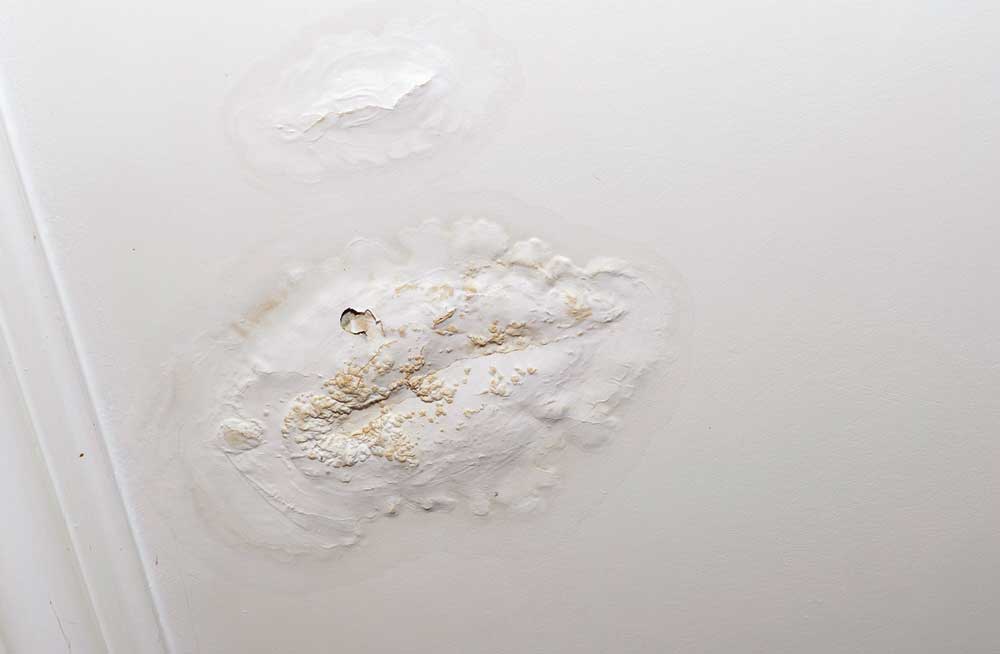Drywall provides an affordable and sturdy solution but is susceptible to damage from water. It’s crucial to promptly address any water-related problems to preserve the structural integrity of your house.
Most drywall repairs cost between $70 and $400 on average. To repair drywall water damage, expect to pay about $240, with an average range of $75 to $350. The minimum cost averages at $70, while the maximum cost can be up to $700.
The cost varies depending on the job size, location, conditions, and the finishing options you choose. You can either DIY the project to save some cash or hire a professional to do the job for you. When looking for an expert to do the job for you, make sure you choose the best fit for the job.
What we cover
ToggleAverage cost to repair water-damaged drywall
Below is a summary of the repair costs.
| National average cost | Low Estimate | High Estimate | Average Range |
|---|---|---|---|
| $240 | $60 | $700 | $75 - $350 |
Drywall water damage repair cost is between $0.45 and $0.65 for materials only. When labor is included, the cost almost doubles with an average of $1.5 to $3.5 per square foot. Labor costs are the most expensive part of drywall repair. That is why most homeowners choose to DIY the projects to save some dollars.
The following is an outline of drywall repair costs per room.
Water-damaged Drywall Cost per foot and room
| Quantity | Low | High | |
|---|---|---|---|
| Per square foot | Per sq. ft. | $1.5 | $3.5 |
| Per room | 10 x 12 | $120 | $240 |
| Labor cost | 1 Hour | $50 | $65 |
| Supplies cost | Per room | $10 | $50 |
| 2 rooms | 2 - 10 x 12 rooms | $240 | $480 |
| 3 rooms | 3 - 10 x 12 rooms | $360 | $720 |
| Repair standard 1,500 sq. ft. house | 1,500 sq. ft. | $1,200 | $3,000 |
Cost to Repair water damaged ceiling
The average cost to repair water damaged ceiling per patch is $342.5 with an average range of $285to $400. The cost of materials only is about $16, with a range of $15 to $17. This cost may vary depending on the location, project size, finish option and condition.
Before fixing your water damaged ceiling, make sure you determine the cause by checking any plumbing problems. You do not want the ceiling to be damaged again soon after you fix it. So, fix any leaking pipes and make sure the entire ceiling is safe from water damage before fixing the issue.
If the water damage is not extensive, you can dry the wet area and repaint it. However, waterlogged drywall sheets should be cut and replaced to protect your home from mold and mildew.
Cost to Repair water damaged Drywall per Square foot
Drywall repair varies depending on the project size, location, and finish options. The cost of repairing water-damaged drywall per square foot is $2.5, coming in between $1.5 and $3.5. The project materials are relatively low, which means the labor cost covers almost ¾ of the overall repair cost.
Most contractors offer a fixed rate for the job, while others charge by the hour. When looking to hire a repair contractor, it is advisable to work with fixed prices because they are more reasonable. More so, the cost remains the same no matter how long it takes unless there are major hiccups.

Cost of complete Drywall Replacement
Replacing drywall is a costly process because it includes demolition and disposal costs besides labor and materials. The average cost to replace drywall is $2.5, coming in between $1.5 to $3.5 per square foot. This price includes the demolition cost of $0.40 to $0.50 per square foot.
For a typical 300 square foot, expect to pay an average price of $1,056, coming in between $943 to $1169 to replace drywall. The cost depends on your location, the complexity of the job and the job size.
Cost of Pro vs DIY Drywall water damage Repair
The complexity of drywall water damage repair depends on the extent of the damage. For small patches, you can DIY the project. For larger patches or drywall replacement, it is best to hire professionals to ensure the project is in good hands.
DIY Cost
It is possible to DIY drywall water damage repair and basically other types of repair as long as you have basic skills. Patching small holes is easy, and you can buy a repair kit at $10 to $30.
However, for larger DIY repairs, you will need about $50 for drywall and other supplies. You will also need a sander at $14 per day, a sawhorse at $38, and a spiral saw at $70 to $80. You will also need mud, tape and screws to complete the project. The average cost of materials and supplies is about $200 to $500.
Once you have all the materials you need for the project, you will need a helper or drywall lift to lift the drywall. Lifting the drywall on your own will hurt your back, and you may injure yourself because the sheets are heavy. Lighter sheets are the best for DIY projects because they are easier to work with.
Although DIY repair jobs will save you lots of cash, they are risky because of injuries and accidents. Also, the job may take longer, and it may not have a professional look and feel. In addition, emergencies like water damage need experts because they are sensitive. Water damaged drywall needs fixing within 48 hours because mold clusters can start growing as soon as the first day.
DIY material expenses
| Low | High | |
|---|---|---|
| A sheet of drywall | $12 | $35 |
| Drywall sheets cost per sq. ft. | $0.40 | $0.65 |
| Drywall sheets cost per room (10 x 12 room) | $48 | $78 |
| Drywall screws | $3 | $6 |
| Joint tape | $2 | $5 |
| Joint compound | $7 | $15 |
| Paint | $15 | $30 |
Professional cost
If you have a busy schedule or are unsure of your DIY skills, hiring professions to handle the project is a good call.
Professional drywall installers near you will not disappoint provided you choose wisely. The cost to hire pros is, however, much higher than DIY. In fact, labor costs about ¾ of the overall project price, which is why most people prefer to do the repairs themselves.
Professionals charge differently depending on the location, but the national average cost is about $240 with a range of $75 to $350. The cost can go down to $60 and as high as $700, depending on the project size.
Some contractors offer hourly rates of about $50 to $65, while pros offer fixed prices. Working with fixed rates is the best, no matter how small the project is. Sometimes, the work may take longer, which means you will pay more for the job. Also, the project may take several days, which makes the rates unreasonable.
A professional with 6 crew members will take a shorter time to complete the project than one with two or three employees. So, hourly rates may not be fixed, and you may pay more for a project that could have cost lower at fixed rates.
Hiring pros may be costly, but you will have peace of mind, and the job will be completed on time. Also, pros will handle the task with expertise and make your home look as good as new.
Signs of water damage in Drywalls
You can easily tell whether your drywall has been damaged by water. The most common signs include stains on the walls and ceilings, peeling or flaking of paint, soft or swollen/sagging walls, musty or stuffy smell in the house, and mold on the basement walls.
If the drywall has been affected by category 3 water damage, you must replace it. This is because sewage or outdoor flooding may bring contamination that may make your drywall a toxic hazard.
Should I Repair or Replace water-damaged drywall?
The decision to repair or replace wet drywall depends on the category of water damage. For instance, if the damage is due to leaking water pipes, and it is not extensive, you may repair the drywall. However, if the damage is extensive, the drywall will lose its structural integrity, and it may collapse, which calls for replacement. For category 3 water damage, such as from sewer pipes or floods, you will be forced to replace the drywall.
Can wet drywall be saved?
Yes, wet drywall can be saved if the damage is minimal. Drywall sheets are highly absorbent, and they will get wet if they are exposed to water for too long. Once you notice water damage on the drywall, act swiftly and dry the material as soon as possible. However, soaked drywall cannot be saved because it will lose its shape and become soft and weak.
What is waterproof drywall?
Waterproof drywall is a more durable drywall type. It is similar to regular drywall, but it comes in a thicker coat of paper covered by wax for waterproofing. This drywall is best for bathroom ceilings and the kitchen, but it should not be used as a tile backer. Examples include purple and green drywall.
FAQ's
Can I paint over water damaged drywall?
Yes, you can paint over water damaged drywall but not until it is completely dry. Once you test and confirm that the affected part is dry, seal it by applying a thin layer of alcohol or oil-based primer. You can then repaint the drywall once the primer dries.
Ensure you find an experienced painting contractor to do the job for you or DIY if you have the time and skills. Sealing the drywall with a primer prevents the stain from coming through.
Is drywall ruined if it gets wet?
When drywall gets wet, it loses its structural integrity, sags, bulges, and even collapses depending on the degree of wetness. If the drywall is completely distorted by water, it cannot be restored, and it will have to be replaced. However, if the water damage is minimal, you can save the drywall by drying and repainting it soon after the exposure.
Do painters repair drywall?
Yes, painters can now repair drywall as well. Once the drywall is repaired, it must be painted and finished to look good. However, the cost of hiring separate drywall repair and painting contractors is high, and most homeowners choose to DIY either the repair or painting part to save on the costs. Luckily, your painting contractor can also repair drywall, so you can get both services from one contractor.
How much does it cost to repair drywall in bathroom?
The average cost to repair bathroom drywall depends on the problem. Fixing small holes averages between $75 and $150, while larger holes, cracks and water damage costs between $220 and $380. If you hire a handyman for the job, you can pay about $50 to $65 per hour with a call-out fee of $50 to $125.
Drywall is prone to water damage, and it should be fixed immediately to prevent mold clusters from growing. If the damage is extensive, the drywall’s integrity will be compromised, which means you will have to replace it. Whether you DIY the project or hire a pro, ensure the job is perfectly done to retain your home’s integrity.












